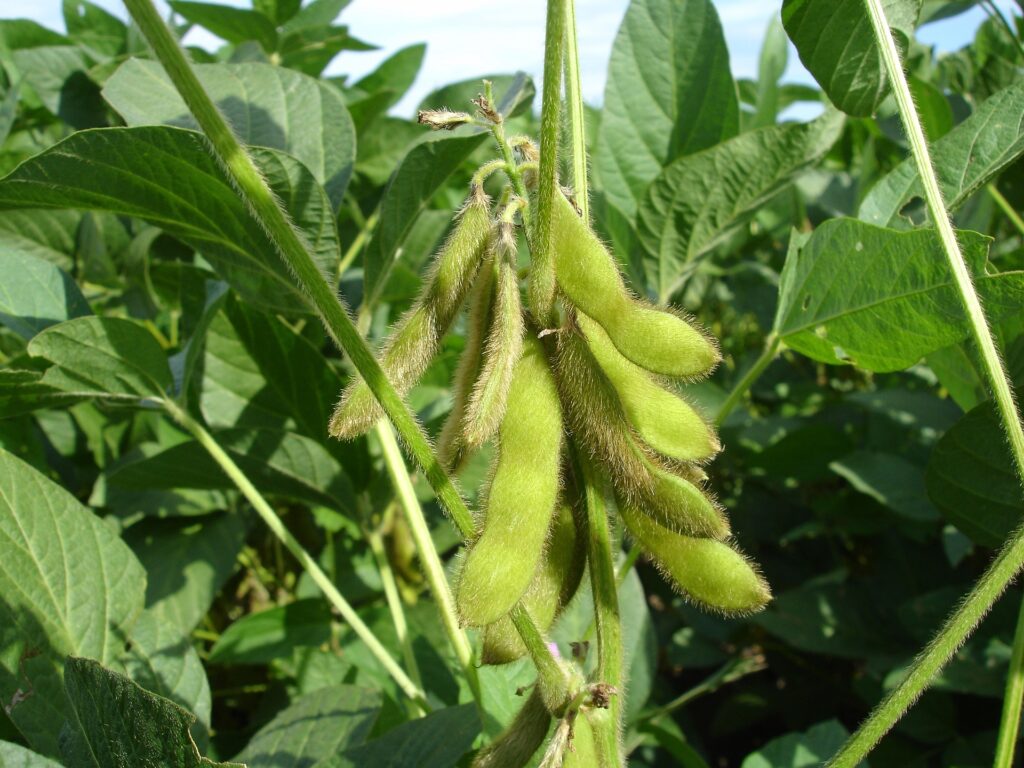Soy
The plant for the vegan meat substitute
General information
Soy milk, tofu or soy yogurt: more and more people are switching to plant-based alternatives.
The more conscious consumption of animal-based foods means that many people are turning to the popular legume. The soybean is one of the oldest crops in the world and is said to have been cultivated in China and Japan over 4,000 years ago. Soy seeds have a high protein and fat content and can be used in a variety of ways as food and animal feed. The global demand for soy is increasing. However, with the increased demand, more or more intensively farmed land is needed to meet the demand. The majority of the soy harvest is used to feed animals; only a small proportion is used directly as tofu on our plates or as soya milk in our coffee.

Growing areas
According to data from the Food and Agriculture Organization (FAO), almost 372 million tons of soybeans were produced worldwide in 2021. Brazil is the country with the largest soy production in the world, closely followed by the USA. A lot of soy is also grown in Argentina, China, India and Paraguay.
In addition to these locations, the soy plant is also becoming increasingly popular in Europe. Italy, France, Serbia, Austria and Romania are the top 5 European countries for soy-growth. Germany follows in 9th place.
Cultivation and harvest
The soya plant is a thermophilic (heat-loving) short-day plant – this means that short periods of light and long periods of darkness are required for flower formation. The ideal growing conditions are therefore provided by warm-temperate subtropical regions with temperatures around 24–25°C. However, if the soy plant is exposed to more than 14 hours of daylight, there is a risk of no or delayed flowering, which means that productive cultivation should take place neither too far north nor too far south.
In terms of water supply, around 500-700mm of rainfall per year is ideal. Short dry periods are not a problem as these are tolerated by the plant and do not have a negative effect on growth. The soy plant generally needs drier conditions for the ripening process, otherwise the quality will be reduced.
Zu den optimalen Bodenbedingungen lassen sich folgende Eigenschaften zusammenfassen: Die Böden sollten tiefgründig, humus- und nährstoffreich sein, sowie einen neutralen pH-Wert (6–6,5) besitzen. Je nach Sorte können diese auch auf leicht alkalischen oder basischen Standorten angebaut werden. Lockere Tonböden sowie sandige Lehmböden eignen sich gut für den Anbau der Sojapflanze, wohingegen schwere staunasse und wasserundurchlässige Böden ungünstig sind.


Products
The soybean is characterized by numerous possibilities for further processing and therefore a wide variety of products. One important use is processing into oil: by extracting the fruits, high-quality cooking oil and margarine can be produced. This also creates products for technical purposes, such as plastic fibers, adhesives and foam agents.
One of the main properties of soy is its high protein content. This means the plant is also ideal as food – for animals and humans. After removing the oil, what is left is what is known as soybean meal, which serves as a valuable source of protein and fat. Because of this and the comparatively cheap cultivation, soy is often used as feed for livestock, most of which is imported to Europe from Brazil. Soy from Europe is also processed into a variety of vegan products, such as tofu, soy milk or yogurt, plant-based cheese or meat substitute products.
Certification
Soya is mainly used as animal feed, with only a very small proportion being consumed directly. The farming associations Bioland, Naturland, demeter and biokreis guarantee that no soy is used in meat production. If there is a crop failure, soy may be added, but only regionally. This means that no rainforest is cut down for animal feed in meat products with these seals. Soy that comes from Europe and the corresponding products made from it are often certified organic.


Sustainability
Soy has become increasingly important in recent decades. Especially due to the disease BSE (bovine spongiform encephalopathy, colloquially known as “mad cow disease”), which led to a ban on feeding animal remains to livestock in Central Europe, a replacement concentrated feed for cattle breeding was sought and found: soy. Meat production represents an expanding market and since the European livestock industry and the production of animal products require huge quantities of soy, which cannot be produced within Europe, the soy is imported. However, rainforest has to be cut down to provide these immense areas for cultivation. Large areas are burnt down, which has fatal consequences for the climate. In addition, the highly industrial production of soy is eliminating jobs in traditional agriculture.